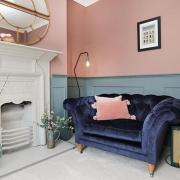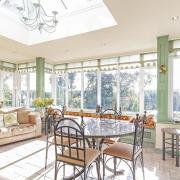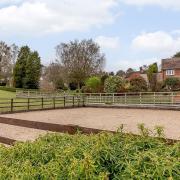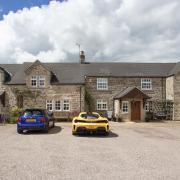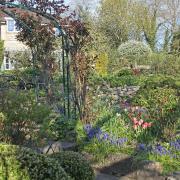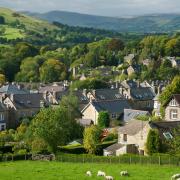A lost suburban villa.
Chesterfield was at one time well endowed with grand suburban villas, some of them country houses absorbed by the expansion of the town, others built by notable burghers wanting rus in urbe. Few of them have been seriously researched and fewer still are well recorded.Last year we looked at one of these, West House, West Bars; today we look at its neighbour immediately adjacent, on rising ground to the north, Rose Hill. I only know of two pictures of the house, both of the south (garden) front, which was of five bays and two-and-a-half storeys under a hipped roof. The house was of brick with sparing stone dressings, and was beautifully proportioned, with five well spaced bays with gauged brick lintels, but largely devoid of ornament. Both views - one a postcard of c.1904, the other taken prior to demolition in winter of 1936-37 - show the fenestration with Victorian (or later) plate glass, which had the effect of increasing the severity of the faade still further. The only decoration was provided by a plat band and sill band on the first floor with balustrading to the windows between them; even the cornice was plain.According to some accounts, however, the entrance front was more like that of West House, which might suggest that the traditional date for the house of 1730 might not be wholly unlikely, although the south elevation looks c.1770/5 in date.The house is said to have been built at the earlier date 'by the Thornhills' which begs the question: which Thornhills?The answer lies in the entrepreneurial career of Henry Thornhill (1708-1790) the fourth son of John, first of his name to be proprietor of the Stanton-in-Peak estate, having married Anne, daughter of Henry Bache of London, and heiress of Raphael Bache of Stanton. The Bache fortune was built on the successful exploitation of the mineral wealth beneath their estate and elsewhere, and John Thornhill, too, in partnership with Nicholas Twigge of Holme Hall, Bakewell (1700-1760), had done well as a lead smelter.Henry was the son who showed real flair for carrying on the family tradition in the lead trade. He was set up by his father at the age of twenty as a lead smelter in Chesterfield, so the possibility of his building a substantial house there - on Rose Hill - is perfectly feasible. Indeed, a document of the following decade describes him as 'of Brickhouse near Chesterfield' which almost certainly refers to this house. Furthermore, not only does it confirm the basis for the old story - unlikely to be at all true - that Rose Hill was in 1730 the first substantial brick house in the town, but also tells us its distinctive name when first built. Indeed, the first reference I can find to it as Rose Hill - the name of the eminence on which it stood - is in the later 19th century.Henry Thornhill operated in partnership with Nicholas Twigge until the latter's death and then with a shifting pattern of other men, and was outstandingly successful financially. He lived on Rose Hill until around 1768 when he moved to Darley Abbey before going to live in London, where he is recorded the following year. In about 1782, he moved his operations from London to Mansfield Woodhouse, where he was living at the time of his death, in order to be close to a pioneering hosiery enterprise he had acquired in Pleasley Vale.In all probability for some time after leaving Chesterfield, he let rather than sold his house there, although for a time it was reserved for use by his elder brother Bache of Stanton Hall as a town house. However, it was acquired around 1779 by Robert Lowndes, by which time it was called the Mansion House.Lowndes, who had been involved with Thornhill in a number of lead-centred transactions, was married to the heiress of Richard Milnes, the second son of James Milnes of Chesterfield. This Richard had, as a young man, acquired Palterton Hall from the break-up of the Earl of Scarsdale's estates in 1738, replacing the house in 1740. It is likely that Lowndes, his son-in-law, took over some of Henry Thornhill's Chesterfield operations when the latter went off to London, and his later acquisition of the house makes sense. It was Lowndes who rebuilt the house in the stripped down neo-classical style seen on the garden front. The date of these works is unknown but it was 'by 1779' according to the late Geoffrey Sadler. Given the urbanity of the proportions of the faade, it could well have been designed by the celebrated John Carr of York for, although he did not design the Chesterfield Guildhall until 1787, he designed a virtually identical house for Lowndes's cousin John Milnes of Wakefield in 1773. What more natural than that his cousin would recommend the man who designed his new house, then. Furthermore, three other Yorkshire houses by Carr - admittedly earlier - all bore a striking resemblance to Rose Hill: Fangfoss Hall (1766), Knaresborough House (1768) and Streetthorpe Hall (1769-1771).In 1797, Lowndes inherited the Palterton estate and his son, Milnes Lowndes died without issue in 1836. The house in Chesterfield passed to his brother, Thomas, who had just purchased Barrington Hall in Essex, and who probably sold it. If not, it would have been disposed of by his nephew and heir Edward Lowndes in 1853. Either way, it was almost certainly tenanted during the first half of the 19th century, although by whom is not clear.The next owner about whom we hear is Chesterfield Alderman John Brown, whose was also agent to the Wingerworth estate of the Hunloke family. Indeed, it is possible that the Hunlokes bought the house from the Lowndes and installed their agent in it, but, as it was by 1891 the home and freehold property of Brown's heir Frederick Butcher (also owner of Cutthorpe Hall) the former suggestion is the more likely.Again, it is unclear who lived in the house after Butcher died, for his son Frederick John Butcher lived at Cutthorpe. In the end, it was purchased by the Borough of Chesterfield in 1936 and preremptorily demolished that winter. Why? To build the Borough's grandiose new town hall of 1938, of course! Rose Hill's pleasure grounds were, at the same time, municipalised into the present surrounding parkland.If Rose Hill was indeed extended by Carr, its demolition represents a serious loss to Chesterfield, a town already very short of quality buildings, especially of the Georgian period.





